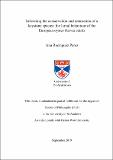Informing the conservation and restoration of a keystone species : the larval behaviour of the European oyster Ostrea edulis
Abstract
The European oyster Ostrea edulis is a keystone species that is internationally recognised as ‘threatened and declining’ in the North-East Atlantic and several nations have adopted strategies for its conservation and restoration. The overall goal of the present work was to inform conservation and restoration efforts. The purpose of this thesis, therefore, was to study the larval behaviour and ecology of O. edulis in as much as is relevant to the dispersal of this species. Specifically, the larvae’s vertical distribution, swimming speeds, settlement preferences and pelagic duration were studied in laboratory experiments. Most larvae concentrated at the bottom of the aquarium, independently of the developmental stage, light, food or temperature. In addition, larvae behaved actively in ~50% of all bottom observations, indicating a behavioural function other than resting. Advection close to the seabed is known to be slower than in any other part of the water column. The observed demersal behaviour would therefore most likely reduce dispersal from natal populations and enhance self-recruitment. At the surface, larvae frequently formed aggregations. In the water column, larvae swam with high vertical directionality and their distribution was homogenous. Swimming speeds ranged from 0.001 mm/s to 9.07 mm/s. O. edulis larvae settled preferentially among conspecifics (100% in < 24h), and if conspecifics were absent, larvae also settled in response to habitat-associated biofilms (81% of settlement after a 45h delay). Sterile shells and terrestrial stones did not induce more settlement than control treatments (0-14% settlement). Pelagic duration was strongly dependent on temperature, food and a suitable settlement cue. In the absence of an appropriate settlement cue, 80% of larvae delayed metamorphosis for up to 14 days, when the experiment was terminated. In contrast, 95-100% of larvae delaying their metamorphosis settled when presented with a conspecific. Such a delay in metamorphosis enhances the risk of predation and, ultimately, of losing most larvae to mortality if target habitats are absent. The results of this thesis provide strong evidence that O. edulis larvae are targeting their own beds, and that the behaviour of larvae plays a crucial role in their dispersal and successful recruitment. Restoring European oyster beds at a scale that is large and dense enough to promote the retention of larvae may be crucial to the success of restoration efforts.
Type
Thesis, PhD Doctor of Philosophy
Rights
Creative Commons Attribution-NonCommercial-NoDerivatives 4.0 International
http://creativecommons.org/licenses/by-nc-nd/4.0/
Collections
Description of related resources
Pelagic larval duration of the European oyster Ostrea edulis (thesis data) Rodriguez Perez, A., University of St Andrews, 18 September 2019. DOI: https://doi.org/10.17630/a846f743-971e-42f9-bd6f-3fd3b9a093eaSettlement preferences of the European oyster Ostrea edulis (thesis data) Rodriguez Perez, A., University of St Andrews, 18 September 2019. DOI: https://doi.org/10.17630/69501ecc-2e4e-45f6-ba3b-7049bcfbf49b
Vertical distribution, swimmings speeds and larval behaviour of the European oyster Ostrea edulis (thesis data) Rodriguex Perez, A., University of St Andrews, 18 September 2019. DOI: https://doi.org/10.17630/08c13f8f-e6f4-4df9-a44c-15bbc1258dbc
Except where otherwise noted within the work, this item's licence for re-use is described as Creative Commons Attribution-NonCommercial-NoDerivatives 4.0 International
Items in the St Andrews Research Repository are protected by copyright, with all rights reserved, unless otherwise indicated.


